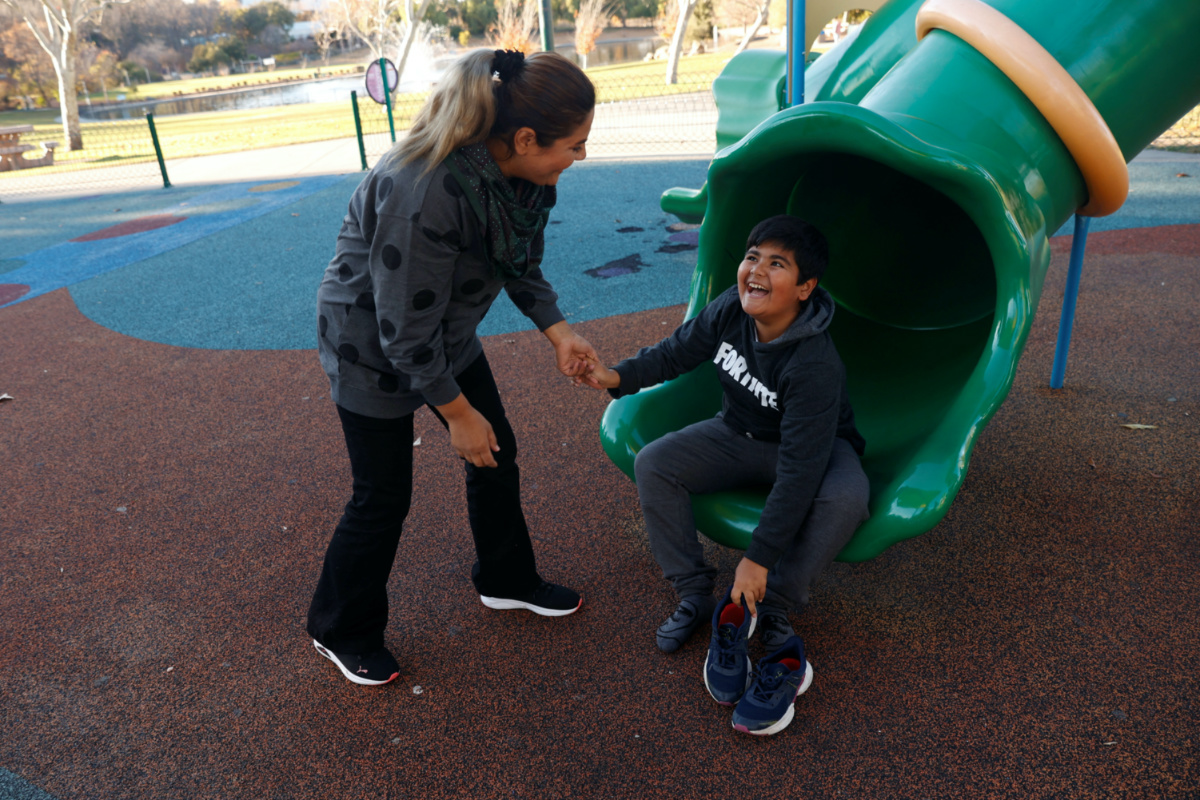
MICA ROSENBERG, KRISTINA COOKE AND JACKIE BOTTS, of Reuters, recount four journeys of Afghan migrants who eventually reached the United States…
San Pedro Tapanatepec, Mexico
Reuters
Their journey starts with a humanitarian visa for Brazil: one of the few remaining exit routes for Afghans fleeing Taliban rule.
It ends, after a perilous trek overland through Latin America across at least 11 countries, with scaling the border wall and jumping onto US soil.

Humaira Ziwari, 31, an Afghan refugee, plays with her eldest son Ahmad Altaf Ziwari, nine, at Heather Farms Park near their home in Concord, California, US, on 13th December, 2022. PICTURE: Reuters/Brittany Hosea-Small/File photo.
More than a year after the chaotic US withdrawal from Kabul, the number of Afghans crossing the US-Mexico border to seek asylum in the United States has soared.
Hundreds of people each month are risking their lives to get there on a human smuggling route notorious for kidnapping, robbery and assault.
“Just getting out of the country is hard. And then if you do, it doesn’t mean that you’ve reached safety.”
– Anne Richard, who served as the US Assistant Secretary of State for Population, Refugees and Migration from 2012 to 2017.
US border agents apprehended 2,132 Afghans last year – a close to 30-fold increase over the prior year – with nearly half arriving in November and December, US government data show.
Reuters spoke to a dozen Afghans who braved the journey. Eleven said they made it to the United States; Reuters has not been able to confirm the whereabouts of one person a reporter interviewed in Mexico. All said they were unable to start new lives in Brazil and instead headed north by land to the United States.
Several refugee advocates and former US officials said the increasing number of Afghans attempting the route reflected a failure both to address the humanitarian crisis inside Afghanistan and to provide adequate support for those who leave.
The United States has been slow to process visas, they say, and together with the United Nations High Commissioner for Refugees should be doing more to help other countries to assist Afghan refugees.
“Just getting out of the country is hard. And then if you do, it doesn’t mean that you’ve reached safety,” said Anne Richard, who served as the US Assistant Secretary of State for Population, Refugees and Migration from 2012 to 2017.
The State Department said in response to Reuters questions that it has tried to speed up visa processing for “the brave Afghans who stood side-by-side with the United States over the past two decades” and that it has offered support to governments to avoid “irregular migration”. It declined to comment on individual cases.
UNHCR said the humanitarian Brazilian visa program, which offers two-years residency and the right to work, study and apply for refugee status, is “an extremely important contribution” but said shelters in the country are “overwhelmed.”
The Brazilian Government did not respond to requests for comment.
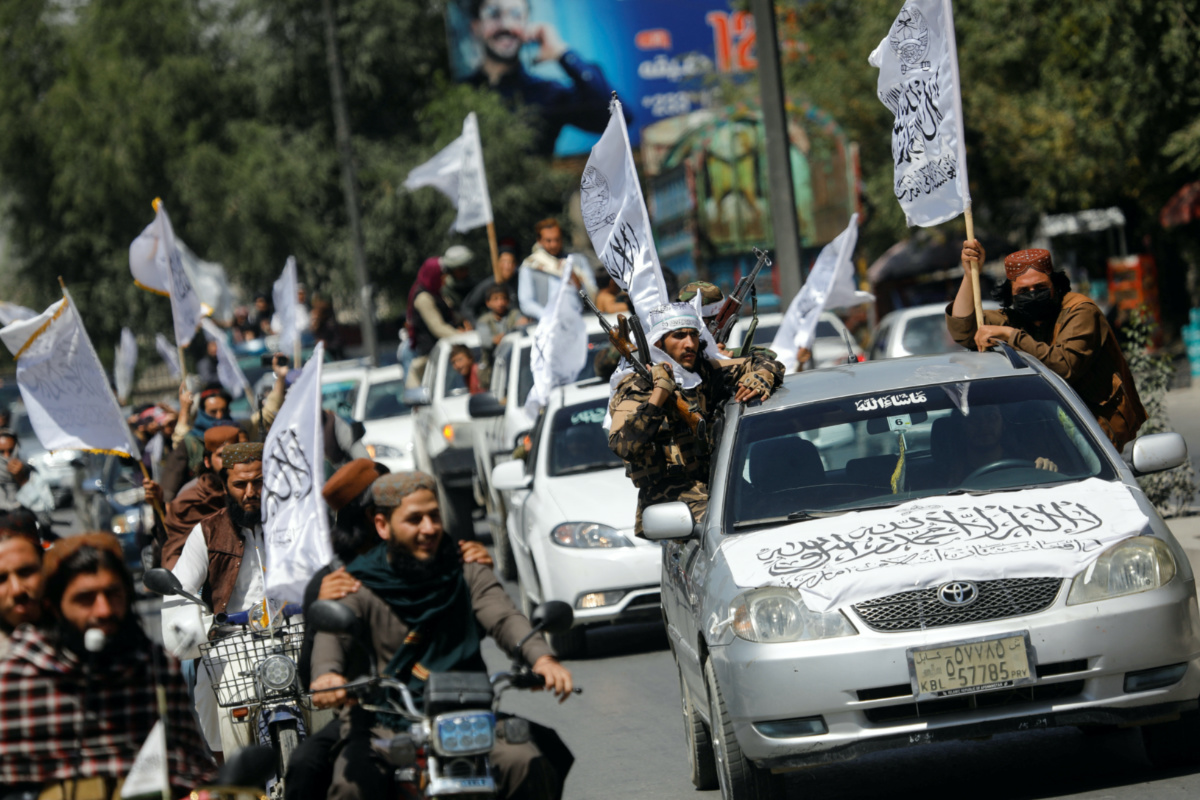
Taliban members drive in a convoy to celebrate the first anniversary of the withdrawal of US troops from Afghanistan, along a street in Kabul, Afghanistan, on 31st August, 2022. PICTURE: Reuters/Ali Khara/File photo
About 4,000 Afghans have entered Brazil on humanitarian visas since the program began in September, 2021, the US State Department said, with a significant uptick in the final months of 2022.
Last year, 2,200 Afghans crossed through the lawless jungle region between Colombia and Panama known as the Darien Gap – the only land route from South America toward the US border – with nearly half crossing in November and December. In all of 2021, just 24 Afghans crossed, according to Panamanian government data.
The Taliban administration’s spokesperson did not respond to requests for comment about the escalating exodus. In recent weeks, Taliban spokesmen have said that Afghanistan is the “home of all Afghans” and that those who have left can come back.
Reuters focused on four journeys by Afghan migrants who reached the United States, corroborating key details of their accounts with emails, official documents, interviews with relatives and co-workers as well as videos, photos and voice memos sent during their travels.
Here are their stories.
Nine days in Sao Paulo airport
When 25-year-old Ilyas Osmani landed in Sao Paulo on 2nd October after more than 30 hours in transit from Tehran, he said he told an official at passport control that he was a refugee and asked for assistance.
The official simply shrugged, Osmani said, and told him he was free to go.
An activist who had spoken about women’s rights several times on Afghan television, Osmani said he feared he was at risk under the Taliban because of his advocacy and his work as a general manager for a logistics company that was a subcontractor for US armed forces.
At baggage claim, he called an Afghan acquaintance who told him to head to Terminal 2, where he could find other Afghans.
Once there, he said, he put his name on a waiting list for shelter spots.
That first night on the cold tile floor of the airport, Osmani said he barely slept.
From a Tajik family in the northern city of Mazar-i-Sharif, Osmani said he had felt lucky when he won a US immigration lottery in 2020 allowing him to apply for a “diversity” visa, designed for nationals of countries with low rates of immigration to the United States.
But precautions during the COVID pandemic delayed visa processing, and the US embassy in Kabul closed when the city fell to the Taliban in August, 2021.
Next, Osmani contacted three additional US embassies to request a visa interview.
The Islamabad embassy said it had reached processing capacity, acknowledging in a Novermber, 2021, email to him “that it is currently very difficult for Afghans to obtain a visa to a third country” and that “many at risk are facing significant challenges fleeing to safety.”
The embassy in Doha said it was only conducting interviews for Qatari citizens and residents while the embassy in Tashkent said it was unable to process Osmani’s case but provided no reason, according to emails reviewed by Reuters.
We rely on our readers to fund Sight's work - become a financial supporter today!
For more information, head to our Subscriber's page.
Around the same time, Osmani also applied for a Special Immigrant Visa, a category for foreign nationals who worked with the United States in Iraq and Afghanistan, based on his work with the US contractor, according to documents he shared. The application is still pending.
About 90,000 Afghans are awaiting decisions on their SIVs, according to Congressional reports from fall 2022.
The State Department told Reuters it has “surged resources” to the SIV program and reviewed “every stage of the cumbersome multiple step application process to streamline wherever possible.”
Osmani fled. In Afghanistan, “no one is safe who was fighting for gender equality,” he said.
The Taliban says its administration respects women’s rights in line with its interpretation of Islamic law and Afghan culture.
With no immediate path to the United States, Osmani applied for a humanitarian visa to Brazil at the end of 2021, he said, hoping to live in a big city where he’d find a job that would allow him to support his parents back home.
After about a week at the airport, still without a shelter spot, Osmani and two other Afghan men went out to see Sao Paulo. On the way back, they were robbed at knifepoint, he said. Reuters was unable to independently confirm details of the attack.
Osmani called his father. “I can’t stay here,” he said he told him.
Osmani’s father put him in touch with his former boss at the Afghan Ministry of Transport, Murtaza Ziwari. Murtaza and his wife, Humaira, were preparing to head to the US with their children.
The Ziwari family had arrived in Brazil on 29th June on humanitarian visas, passport stamps viewed by Reuters showed. On 12th October, they set out for Rio Branco, a remote city on the border with Peru, where Osmani joined them.
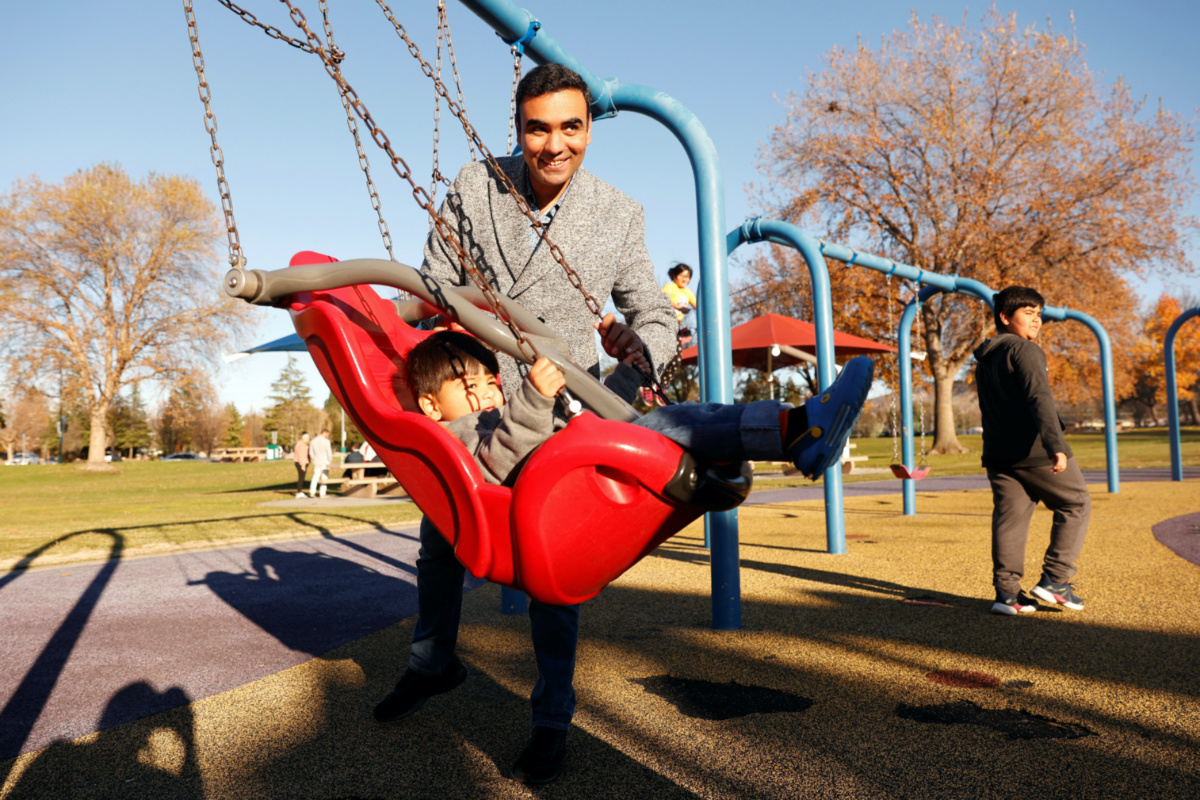
Murtaza Ziwari, 37, an Afghan refugee, plays with his son Ahmad Spanta Ziwari, two, at Heather Farms Park near their home in Concord, California, US, on 13th December, 2022. PICTURE: Reuters/Brittany Hosea-Small/File photo.
Overland across a continent
By the time she found herself trying to comfort three vomiting and exhausted young sons on a four-day bus journey across Peru, Humaira Ziwari had spent months struggling with the trauma of leaving home.
“My mental state was not good,” she said.
In Iran, where the family said they spent eight months waiting for their Brazilian visas, Humaira had been distraught, weeping over photos of weddings and family gatherings on her phone.
A 31-year-old homemaker, Humaira said she had never imagined a life outside Afghanistan. Murtaza, working in Herat province according to identification documents shared with Reuters, said he feared his job – which included overseeing civilian fuel distribution to gas stations and to U.S.-aligned military forces – would make him a target.
Armed men had shown up at Murtaza’s family home in Mazar-i-Sharif asking for him the day after the Taliban took the city in August 2021, according to home security camera footage shared with Reuters.
The Taliban did not respond to requests for comment on allegations of retaliation against former Afghan government officials. They announced a general amnesty shortly after taking over and have pledged to investigate individual cases.
RELATED: “Life is tough here”: In Pakistan, Afghan refugees face hardship and a frosty reception
The Ziwaris fled to Iran overland, carrying one change of clothes and some money from selling Humaira’s jewelry.
In Sao Paulo, they bounced from the airport floor to a church stockroom to a drafty NGO event space for months. Murtaza couldn’t find work. The kids suffered constant colds.
So in mid-October, Murtaza said, they took a bus to Rio Branco, before making their way by foot, bus and taxi through Peru, Ecuador and Colombia.
At the Ecuador-Colombia border they said they paid $US80 to a smuggler to be shepherded across, only to have him drop them off at the Colombian check point where officials wanted to send them back to Ecuador.
“The police were pulling us in one direction. The kids were screaming,” Humaira said. Somehow the family managed to break away from the border guards and run.
Colombia’s migration authority did not respond to questions about the incident or about the treatment of Afghan migrants crossing through Colombia.
Soon the Ziwaris would be on the brink of a more terrifying leg of the journey: the no-man’s-land between Colombia and Panama.
Trekking pregnant through a jungle
Nahida Nabizada had heard about the Darien Gap, a dense, lawless jungle that can only be traversed by foot. She didn’t want to go.
The 29-year-old was nearly two months pregnant, her second pregnancy after miscarrying at five months.
“I didn’t want to lose this child too,” she said.
She thought: ‘What will happen if I start bleeding? There are no doctors; my parents aren’t there; there’s not enough food. If I am too slow, no one will wait for me.’
A university graduate with a computer science degree, Nahida felt unsafe when the Taliban took over.
An economic crisis has spiraled in the country. More than half the population relies on humanitarian assistance.
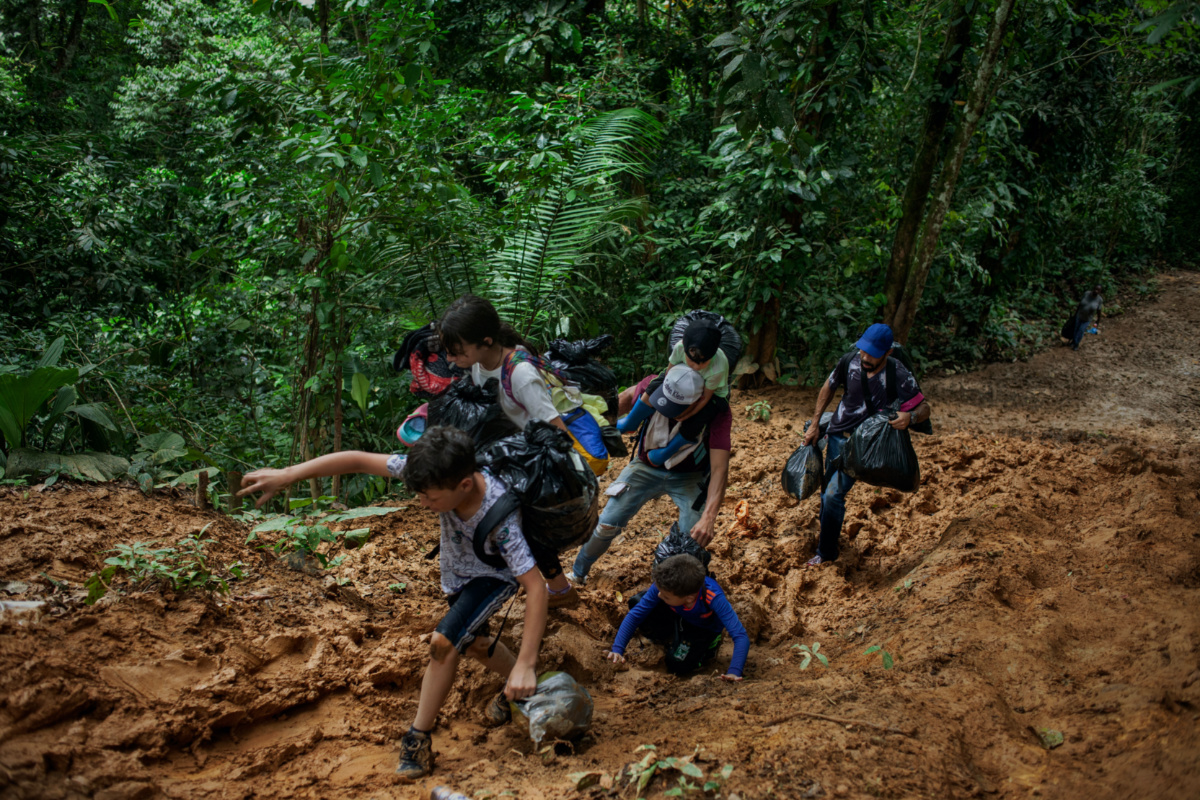
A family of Venezuelan migrants with young children walk through the Colombian jungle in the Darien Gap on day one of a five-to seven-day perilous and exhausting trek through the Darien Gap, Colombia, on 27th July, 2022. PICTURE: Thomson Reuters Foundation/Fabio Cuttica/File Photo.
Nahida and her husband Jamshid decided in late 2021 to leave.
While about 88,500 Afghans have been resettled in the United States since the US troop withdrawal, according to the US Department of Homeland Security, thousands more have applied to leave the country.
From 51,000 applications to enter the United States on an emergency basis following the Taliban takeover, only around 600 Afghans have been approved, DHS said.
After reaching Brazil in mid-2022, Nahida realised she was pregnant again. Staying behind while her husband tried to reach the US by himself could have meant years of separation.
So, in late 2022 they headed into the Darien where, Nahida said, “every step was filled with danger.” She fell multiple times as they walked from daybreak to dusk, slipping on steep muddy paths and once falling in a river.
The local guide they hired for $US150 left them on the first day, midway through a 12-hour trek, Jamshid said.
On the third night, a river overflowed and washed away their food, flashlight, sleeping mats and other belongings. Nahida said they survived on biscuits and dates, drinking river water.
A few days later, thieves armed with knives stole $US200 in cash from Jamshid, he said.
When they emerged from the jungle, they were met by Panamanian soldiers who took them to a migrant camp. Soldiers routinely escort migrants to encampments to give them food, water and clothes and collect identifying information.
In response to Reuters questions, the government said: “Panama is the only country that provides care to all migrants who enter the country through Darien, so that they continue on their way to North America.”
After a short stay in the camp, the Nabizadas took a bus to Costa Rica on their way north through Central America towards Mexico.
On the run from police in Mexico
When Fazal Khalili, 25, climbed out of a smuggler’s boat on the Pacific coast of southern Mexico in October, 2022, he had been at sea for more than 12 hours.
“There was a lot of water inside our boat,” said Khalili, who said he boarded the vessel near the border with Guatemala along with eight family members – including his 87-year-old grandmother and nine-year-old-cousin – and more than a dozen migrants from other countries.
From the boat, the migrants headed to a sprawling migrant camp in the southern state of Oaxaca, where they slept in tents amid heavy rains, waiting for Mexican government documents that would allow them to travel within the country, Khalili said.
Born in Kunar province in northeastern Afghanistan, Khalili said he did electrical work on a US military base. In October, 2021, he applied for a SIV, but wasn’t assigned a case number until August 2022, visa application documents show. By that time, he’d flown to Brazil.
It was early December by the time Khalili’s family bought tickets on a commercial bus from Mexico City to Tijuana, snaking through some of the regions of Mexico considered most dangerous by the US State Department because of violent crime and kidnapping.
In Sinaloa state, he recounted, a man in a balaclava with a gun hooked to his belt boarded the bus and demanded money while another man in what appeared to be a police uniform looked on. Khalili said the men got off the bus after his family paid the masked man 34,000 pesos ($US1,700).
Khalili recorded a video of the incident which he shared with Reuters soon after it occurred. Reuters couldn’t confirm the payment.
In the border state of Sonora, immigration authorities stopped the bus, Khalili said, ordering the driver to take the migrants to an immigration office.
Fearing they would be deported, the migrants scattered, wandering for hours through dense desert brush.
Mexico’s National Institute of Migration (INM) did not respond to questions about Khalili’s experience in Mexico.
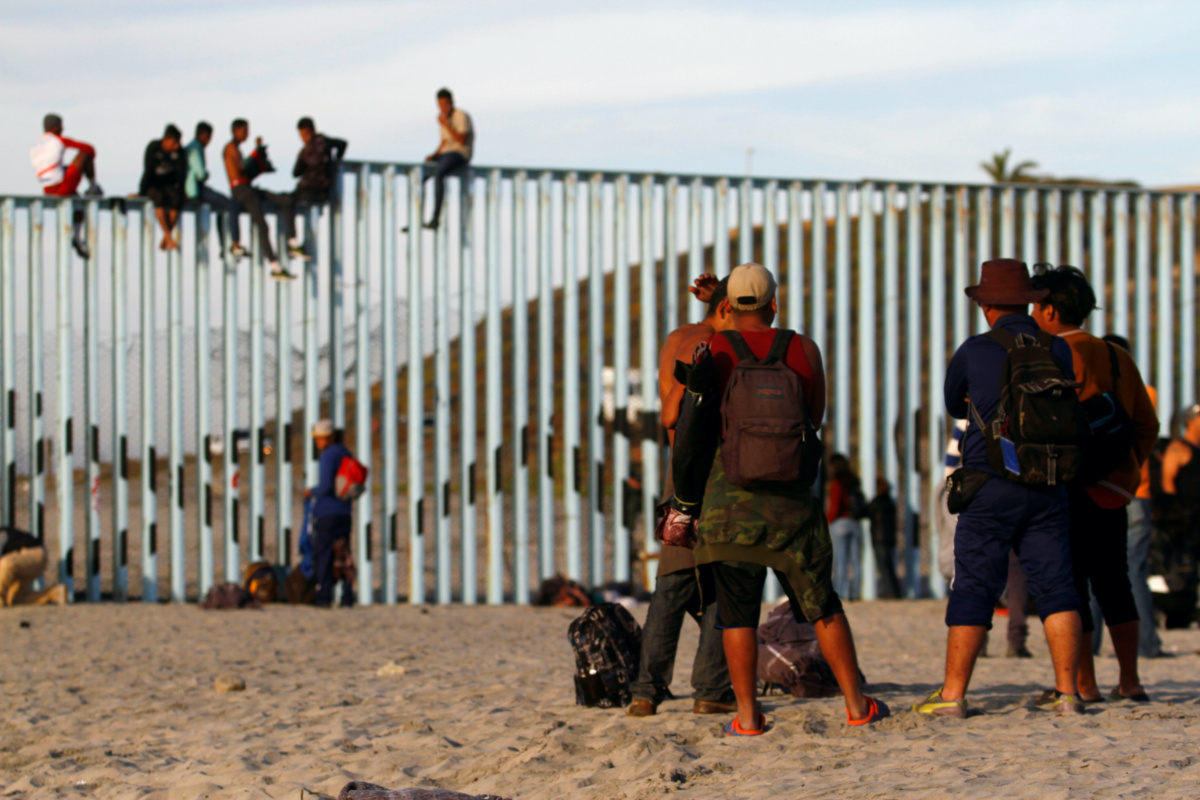
Migrants, part of a caravan of thousands trying to reach the US, gather at the border fence between Mexico and the United States after arriving in Tijuana, Mexico, on 13th November, 2018. PICTURE: Reuters/Jorge Duenes/File photo.
Around midnight about a week later, Khalili and his family huddled below the 18-foot slatted steel wall separating Tijuana from San Diego, preparing to scale a flimsy ladder and jump into the United States, he said.
He helped his grandmother descend by sliding down the steel slats with her feet on his shoulders, he said.
Border agents took the migrants to a detention centre, Khalili said, and about 36 hours later, he was released into the United States with a notice to appear in immigration court in May.
The US Department of Homeland Security did not respond to questions about the border crossings and immigration cases of the Afghans profiled in this story.
Reflecting on the harrowing journey Khalili said he would counsel other Afghans not to risk it. “They must not come this way.”
– Additional reporting by ANTHONY BOADLE in Brasilia, Brazil, ELIDA MORENO in Panama City, Panama, JULIA SYMMES COBB in Bogota, Colombia, and the Kabul newsroom






